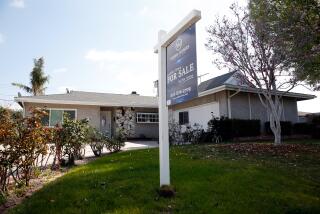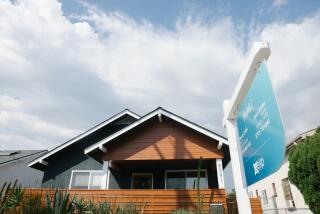New-home sales in the West entirely powered February’s nationwide jump

A “sold” sign sits in front of the foundation of a house under construction in Plano, Texas, as workers discuss plans Feb. 2.
- Share via
U.S. homebuyers in the West accounted for all of February’s increase in sales of new houses, possibly signaling uncertain growth prospects for the broader real estate market heading into the spring buying season.
The Commerce Department said Wednesday that new-home sales rose 2% last month to a seasonally adjusted annual rate of 512,000. All of the increase came from 38.5% surge in purchases in the West, which reversed a stiff 32.7% decline in January that had cut into overall sales.
The rebound probably reflected a government report that can be extremely volatile on a monthly basis, clouding some views of where the construction and housing markets are heading at the start of the most intense months for home sales.
“At this stage, it is unclear whether new-home sales are plateauing or are still in an uptrend,” said Joshua Shapiro, chief U.S. economist at MFR, a forecasting firm.
The U.S. housing market looks somewhat more tempered after strong growth in 2015. Sales in the first two months of 2016 ran slightly below last year’s pace. Builder confidence has held steady despite a dip in sales expectations. Purchases of existing homes tumbled in February, with the prior two months of healthy sales probably straining already tight supplies.
Price pressures are mounting as the share of new homes being sold for less than $200,000 has declined this year, while the share of new homes selling for more than $400,000 has risen. New-home sales fell in the Northeast, Midwest and South in February. The median new-home sales price rose 2.6% from a year earlier to $301,400.
The market still has yet to fully rebound from the housing crisis of nearly a decade ago. New-home sales remain well below the historic 52-year average of 655,200, a figure that includes the build-out of the suburbs and influx of buyers after World War II. Subprime mortgages helped push up sales as high as 1.28 million in 2005, which in hindsight was an alarm sounding about an imbalanced, debt-ridden economy that shortly tumbled into the worst economic downturn since the Great Depression.
Sales of existing homes fell 7.1% last month to a seasonally adjusted annual rate of 5.08 million, the National Assn. of Realtors said Tuesday. The decline follows robust yearly sales rates of 5.47 million in January and 5.45 million in December. A new regulation had delayed closings in November.
The limited supply of houses have pushed up prices and curbed sales.
For existing homes, the median home sales price was $210,800 in February, a 4.4% annual increase from a year earlier, while the number of listings fell 1.1% from a year earlier.
U.S. homebuilders are unlikely to alleviate the supply crunch. They are still optimistic about the housing market, but many anticipate a pullback in sales.
The National Assn. of Home Builders/Wells Fargo builder sentiment index released Tuesday stayed at 58 in March for the second straight month.
Readings above 50 indicate that more builders view sales conditions as good rather than poor. Before February, the index had been in the low 60s for eight months.
Builders’ view of current sales conditions held steady, while a measure of traffic by prospective buyers increased. But builders’ outlook for sales over the next six months fell to the lowest level in 12 months.
More to Read
Inside the business of entertainment
The Wide Shot brings you news, analysis and insights on everything from streaming wars to production — and what it all means for the future.
You may occasionally receive promotional content from the Los Angeles Times.










